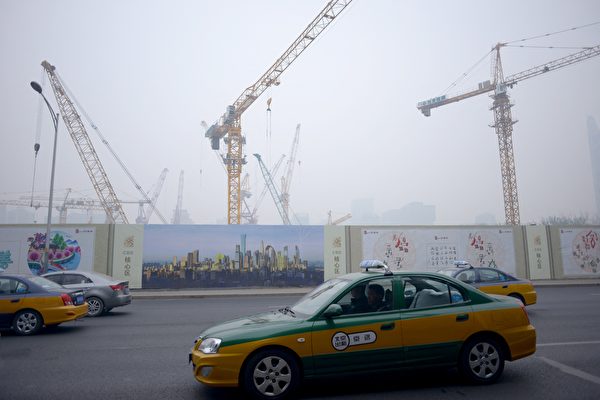Recent large-scale taxi strikes have occurred in northeastern China’s Liaoning and Jilin provinces. Thousands of taxi drivers in these areas went on strike from November 21 to 24, demanding government action to crack down on “black cars” and illegal ride-hailing services, as well as improve the operating environment of the industry.
In Liaoning’s Fuxin City on November 21, around 3,000 taxis collectively ceased operations and gathered to protest. Drivers expressed concerns about the influx of “black ride-hailing cars” onto platforms, further compressing their already meager incomes. Some drivers stated that despite working long hours, they struggled to maintain a basic living.
According to some on-site drivers, some taxi fleets attempted to drive collectively to Shenyang to protest, but were intercepted by police along the way. Following public attention to the issue, the Fuxin City Transportation Comprehensive Law Enforcement Team announced on the evening of the same day that they would clear out vehicles not possessing ride-hailing transport permits from platforms like Didi by November 26 in response to the drivers’ demands.
A driver surnamed Zhao from Fuxin Sunshine Taxi Company told reporters that over a thousand drivers in the area were on strike. He stated, “There were over 800 drivers on strike a few days ago. Now there are too many illegal cars, we work 10 hours a day but can’t even earn enough for fuel. There are more illegal cars than ours, they can easily get orders on the platform, we old taxi drivers can’t compete. If they don’t take action, we have no choice but to go on strike, or else we’d be losing money.”
Just three days later, a similar action erupted in Jilin’s Songyuan City. Videos recorded by local drivers showed numerous parked vehicles on city roads, with several police cars stationed along the routes. Taxi fleet leaders claimed that at least two thousand vehicles did not operate during this time. Songyuan drivers similarly reported that the market was flooded with ride-hailing cars, coupled with the popularity of private vehicles and shared mobility services, causing a significant drop in traditional taxi revenue. “Now working 10 hours a day doesn’t earn as much as six hours did five years ago,” a driver wrote on a social media platform.
Local governments subsequently dispatched transportation department officials to communicate with driver representatives, stating that they would strengthen the crackdown on illegally operating vehicles, although no specific governance details have been announced. A call by a reporter to the Songyuan City Transportation Bureau office of the Chinese Communist Party was met with a response that the matter was “currently being handled,” before the call was abruptly ended.
According to statistics from the private monitoring platform “Yesterday” since 2025, over a dozen taxi driver strikes have occurred in the three northeastern provinces. The project cited strike causes such as declining income, imbalanced market competition, shrinking ride-hailing demand, and the longstanding presence of illegal operations.
In resource-depleted cities like Fuxin, the local taxi industry has seen a significant downturn due to the contraction of coal mining and related industries, leading to a large number of workers transitioning to the taxi sector following mass unemployment. Over the past few years, local governments mass-issued taxi licenses to boost fiscal revenue, resulting in an oversupply situation within smaller city scopes.
In the case of Fuxin, with a population of around 1.6 million and a GDP of about 65 billion yuan in 2024, there were over 3,000 taxis, equating to roughly one taxi for every 533 individuals, a quantity density comparable to larger cities like Beijing and Shanghai. This unequal supply-demand structure was characterized as “extremely saturated” by the “Yesterday” project.
Although taxi industry revenues continue to decline, many drivers find it difficult to transition to other occupations. Several drivers mentioned that the investment in taxi licenses and vehicles often amounted to hundreds of thousands of yuan, making it challenging to sell off in a depressed market. Additionally, with drivers being relatively older and lacking reemployment skills, the high cost and limited opportunities of transitioning present significant hurdles.
A driver from Fuxin commented online, “I know that the taxi industry is a setting sun industry, but the car was purchased through a loan, if I don’t run it, I can’t pay it off; no one wants someone of my age for other jobs.”
An expert named Li from Shenyang believes that the taxi industry in the three northeastern provinces is undergoing a significant structural decline due to changes in urban economic structure, impact of internet platforms, and shifts in residents’ travel patterns. He told reporters that the frequent occurrences of taxi strikes reflect the traditional industry’s struggle to adapt to new market competition, as well as highlighting deeper issues of regional economic weakness.
As of now, the demands of taxi drivers in these areas have not been fully addressed, and local governments have yet to announce long-term industry reform plans. Observers suggest that if the issues of supply-demand imbalance and regulatory challenges remain unresolved, similar strike events could recur in the future.

